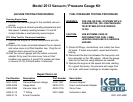
VACUUM TESTING PROCEDURES
Running Engine Tests
1. Connect the vacuum gauge to the manifold vacuum
source.
2. Run the engine at normal operating temperature and
idle speed. A steady reading between 15 and 22
inches indicates a mechanically sound engine.
PCV Valve Test For Crankcase Ventilation
1. Operate the engine at normal temperature and idle
speed.
2.Remove the hose connected between the air cleaner
and valve cover or oil filler/breather cap. Plug the oil
dipstick tube to prevent an air leak.
3.Hold the vacuum gauge with the rubber universal
adapter firmly over the valve cover hole or filler/
breather cap opening. A good PCV system will draw
a vacuum of 3 to 5 inches within 10 seconds.
Repair Parts List
Part Number Description Part Number Description
0031-0424 Vacuum/Pressure Gauge 0180-1497 Conical Adapter
0400-3008 Gauge Boot 0400-3115 Fuel Line/Universal Adapter
0400-0384 Vacuum Hose, 24” 0400-3116 Carry Case
0400-3113 ‘T’ Fitting 0001-3468 Instruction Label
0400-3114 In-line Connector
0001-000-3468
Model 2513 Vacuum / Pressure Gauge Kit
FUEL PRESSURE TESTING PROCEDURE
WARNING: FOR USE ON FUEL SYSTEMS WITH A
CARBURETOR, OR LOW-PRESSURE
TBI SYSTEMS NOT EXCEEDING
15 PSI.
CAUTION: USE EXTREME CARE IN
DISCONNECTING FUEL LINES.
LEAKING GASOLINE IS A SERIOUS
HAZARD.
1. Check all fittings, connections, and rubber fuel lines
for leaks. If leaks are present, repair leaks before
testing.
2. Disconnect the fuel line between the fuel pump and
the carburetor or the TBI system. Attach the gauge
hose to the fuel line using adapters as needed.
3. Operate the engine at idle speed and note reading.
On a good fuel pump, the pressure will range from
4 to 6 psi, with lower readings on smaller engines.



